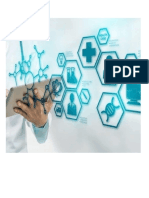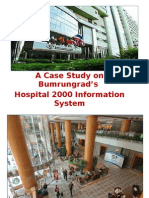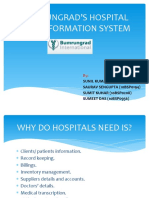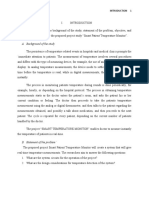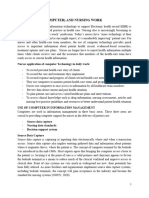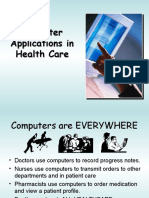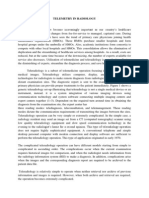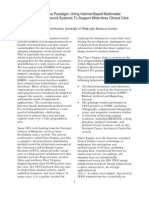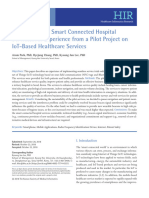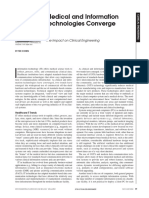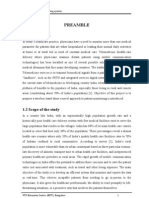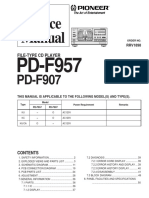Bumrungrad Hosp Case Study 1
Bumrungrad Hosp Case Study 1
Uploaded by
ayusha chandrikapureCopyright:
Available Formats
Bumrungrad Hosp Case Study 1
Bumrungrad Hosp Case Study 1
Uploaded by
ayusha chandrikapureOriginal Title
Copyright
Available Formats
Share this document
Did you find this document useful?
Is this content inappropriate?
Copyright:
Available Formats
Bumrungrad Hosp Case Study 1
Bumrungrad Hosp Case Study 1
Uploaded by
ayusha chandrikapureCopyright:
Available Formats
ASSIGNMENT -2
Bumrungrad's Hospital 2000 Information System
Q1.Bumrungrad upgrade its information systems in late 1990’s. Explain the rationale for Bumrungrad to
make significant investments in upgrading these systems.
Ans1. Bumrungrad upgraded it’s IS in the late 1990’s and the rationale for Bumrungrad to make
significant investments in the upgrading systems were:
It would help in accessing several needs of Bumrungrad at one go.
It would simplify its internal operations which was primarily billing by connecting all the
applications from the pharmacy to eating outlets to the patient’s medical
treatment which would help in generating consolidated medical bills.
Quicker treatments could be done as well for patients at clinics within the
premises thereby saving the hospital’s money and time in administering medical services.
It would also help the foreign patients of different nationalities to get all the necessary
information in their languages also helping to book appointments and
accommodation online.
Q2. Bumrungrad's previous information system had several problems which the new system had to
address. Describe the features and the architecture of the new system. Discuss how it solved the problems
of the old systems faced by Bumrungrad, earlier.
Ans2. Features and the architecture of new system involved:
Picture Archive Communication System (PACS) also known as Amalga
comprised all X-ray images stored in digital format thereby helping them in performing radiology
studies digitally instead of using films. It also provided the radiologists of the hospital the access
to several medical studies and reports through the internet and LAN. It also helped them with the
data in different languages.
Easy accessibility of the results was also an important feature as results consisting of a simple
blood check-up or high-tech magnetic resonance image scans could be accessed by 900 clients
across the hospitals.
Quick treatment of the patients was also one of the features as it helped the hospital to treat an
estimate of 3000 patients every day.
Multi-lingual capabilities were the major benefit of this system. Files containing all the medical
records, bills, drugs and labels could be easily translated in different languages like Japanese,
Chinese and English.
You might also like
- Hospital's Patient Records Managing Web Using PHP, MySqlNo ratings yetHospital's Patient Records Managing Web Using PHP, MySql14 pages
- Features and The Architecture of The New System. Discuss How It Solved The Problems of The Old Systems Faced by Bumrungrad, EarlierNo ratings yetFeatures and The Architecture of The New System. Discuss How It Solved The Problems of The Old Systems Faced by Bumrungrad, Earlier2 pages
- Design and Implementation of Automated PNo ratings yetDesign and Implementation of Automated P19 pages
- Ans-Bumrungrad Upgraded Its IS in The 1990's and To Make Significant Investment in Upgrading Systems100% (4)Ans-Bumrungrad Upgraded Its IS in The 1990's and To Make Significant Investment in Upgrading Systems3 pages
- Lecture and Laboratory in Nursing InformaticsNo ratings yetLecture and Laboratory in Nursing Informatics6 pages
- Health Systems and Technology: Course Number: CIS 1200 Dowling CollegeNo ratings yetHealth Systems and Technology: Course Number: CIS 1200 Dowling College11 pages
- A Complex System For Telemonitoring of Medical Vital SignsNo ratings yetA Complex System For Telemonitoring of Medical Vital Signs8 pages
- Bumrungrad's Hospital 2000 Information System100% (1)Bumrungrad's Hospital 2000 Information System14 pages
- Ictm Hospital Information System (Week 10)No ratings yetIctm Hospital Information System (Week 10)4 pages
- Hospital Management Sysytem A Project Report: Submitted byNo ratings yetHospital Management Sysytem A Project Report: Submitted by23 pages
- Human Body Area Networks: Dr. P. Bhaskara Reddy, G. Prabhakara Reddy, V. Koti ReddyNo ratings yetHuman Body Area Networks: Dr. P. Bhaskara Reddy, G. Prabhakara Reddy, V. Koti Reddy8 pages
- Online Patients Record Platform Using PHPNo ratings yetOnline Patients Record Platform Using PHP31 pages
- The New Telemedicine Paradigm: Using Internet-Based Multimedia Electronic Medical Record Systems To Support Wide-Area Clinical Care DeliveryNo ratings yetThe New Telemedicine Paradigm: Using Internet-Based Multimedia Electronic Medical Record Systems To Support Wide-Area Clinical Care Delivery3 pages
- Hospital Management System Software A Case Study of Olabisi Onabanjo University Health Service CentreNo ratings yetHospital Management System Software A Case Study of Olabisi Onabanjo University Health Service Centre12 pages
- The Potential of Telemedicine System: An Approach Towards A Mobile DoctorNo ratings yetThe Potential of Telemedicine System: An Approach Towards A Mobile Doctor6 pages
- GPS and GPRS Based Tele Monitoring System For Emergency Patient TransportationNo ratings yetGPS and GPRS Based Tele Monitoring System For Emergency Patient Transportation8 pages
- Tuy Municipal Health Center Information SystemNo ratings yetTuy Municipal Health Center Information System10 pages
- Huawei One Net Small - and Medium-Sized Hospital Network SolutionNo ratings yetHuawei One Net Small - and Medium-Sized Hospital Network Solution16 pages
- Mini Project:: IT Implementation On Dr. Kunal Dental ClinicNo ratings yetMini Project:: IT Implementation On Dr. Kunal Dental Clinic8 pages
- Unit 1 - Telehealth Technology Anna UniversityNo ratings yetUnit 1 - Telehealth Technology Anna University30 pages
- Major Jacob Makau Project full compresiveNo ratings yetMajor Jacob Makau Project full compresive14 pages
- Referral and Record Keeping: Beringuel, Christian JosephNo ratings yetReferral and Record Keeping: Beringuel, Christian Joseph5 pages
- Medical and Information Technologies Converge Medical and Information Technologies ConvergeNo ratings yetMedical and Information Technologies Converge Medical and Information Technologies Converge7 pages
- NCM110 Applications of Nursing Informatics BSN3No ratings yetNCM110 Applications of Nursing Informatics BSN352 pages
- A Simplified Nursing Informatics.: A Modern Age Health Technology for Nurses and MidwivesFrom EverandA Simplified Nursing Informatics.: A Modern Age Health Technology for Nurses and MidwivesNo ratings yet
- Keychain Analysis With Mac OS X Memory ForensicsNo ratings yetKeychain Analysis With Mac OS X Memory Forensics16 pages
- ASQ Best Practices For Process ValidationNo ratings yetASQ Best Practices For Process Validation26 pages
- Multi Modal Discourse-Critical Analysis O'HalloranNo ratings yetMulti Modal Discourse-Critical Analysis O'Halloran31 pages
- Marvell Alaska 88E3082/88E3083: Integrated 8-Port 10/100BASE-T Fast Ethernet TransceiversNo ratings yetMarvell Alaska 88E3082/88E3083: Integrated 8-Port 10/100BASE-T Fast Ethernet Transceivers2 pages
- Operations Management: - Design of Goods and ServicesNo ratings yetOperations Management: - Design of Goods and Services26 pages
- Apache Iceberg - Additional Real World Use CasesNo ratings yetApache Iceberg - Additional Real World Use Cases25 pages
- Lzv2622 Series Manual Trilingual R4-WebNo ratings yetLzv2622 Series Manual Trilingual R4-Web72 pages
- T&B Sanitary Layout Unit 6 & 7 at 15th-37th Floor Pl02No ratings yetT&B Sanitary Layout Unit 6 & 7 at 15th-37th Floor Pl021 page
- MS28774 Retainer, Packing Backup, Single Turn, PolytetrafluoroethyleneNo ratings yetMS28774 Retainer, Packing Backup, Single Turn, Polytetrafluoroethylene6 pages
- Topic: Parallel DAC 0808 Interfacing With 8051No ratings yetTopic: Parallel DAC 0808 Interfacing With 805112 pages
- Hfe Pioneer Pd-f907 f957 Service en Rrv1898No ratings yetHfe Pioneer Pd-f907 f957 Service en Rrv189854 pages
- Linux Chown Command: Updated: 01/24/2018 by Computer HopeNo ratings yetLinux Chown Command: Updated: 01/24/2018 by Computer Hope9 pages
- 1 The Error in Polynomial InterpolationNo ratings yet1 The Error in Polynomial Interpolation13 pages
- The E-Stim Systems ElectroPebble XPF Pleasure PackNo ratings yetThe E-Stim Systems ElectroPebble XPF Pleasure Pack1 page
- EVK3 GENX320 Prophesee Evaluation Kit Camera Manual 1No ratings yetEVK3 GENX320 Prophesee Evaluation Kit Camera Manual 115 pages
- Carlos Muñoz Razo Como Elaborar y Asesorar Una Investigacion de Tesis 2edicionNo ratings yetCarlos Muñoz Razo Como Elaborar y Asesorar Una Investigacion de Tesis 2edicion42 pages




